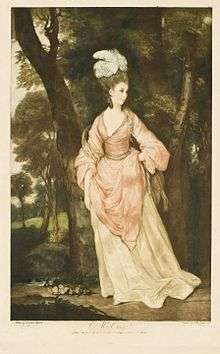John Carnac
| John Carnac | |
|---|---|
| Born | 1716 |
| Died |
29 November 1800 Mangalore, British India |
| Allegiance |
|
| Service/branch | British Army |
| Rank | Brigadier General |
| Commands held | Indian Army |
Brigadier-General John Carnac (1716 – 29 November 1800) was a British officer who served three times as Commander-in-Chief of India.
Military career
Educated at Trinity College, Dublin,[1] John Carnac voyaged to India as a lieutenant in the 39th Regiment in 1754[1] and served at Madras as secretary and aide-de-camp to the colonel of the regiment, John Adlercron.[1] He joined the service of the East India Company as Captain in 1758 after transferring from the 39th foot.[1] After his arrival in Bengal he became secretary and aide-de-camp to Robert Clive, governor of Bengal, and joined him in an expedition against the Prince Ali Gauhar, son of the Mughal emperor Alamgir II.[1]
In 1761 he engaged with and defeated Shah Alam II.[1] He became Brigadier-General in 1764[1] and participated with Clive in the negotiations with Shuja-ud-Daula and the Mughal emperor Shah Alam II in 1765.[1]
In 1767, Carnac resigned from the company's service in January and returned to England.[1] He purchased an estate near Ringwood in Hampshire and also participated in a largely unsuccessful housing development in Southampton.[1] From 1768 to 1773 he served as M.P. for Leominster. In 1772 he was elected a Fellow of the Royal Society.[2]
By 1773 Carnac was short of money and he returned to India as a member of the Council at Bombay.[1] He was dismissed from the East India Company for his involvement in the Convention of Wadgaon in 1779[1][3] and died at Mangalore in November 1800.[1]
Family

In 1765 John Carnac married Elizabeth Woollaston.[1] Then in 1769 he married Elizabeth Catherine Rivett[1] (1751–80), daughter of Thomas Rivett (1713-1763),[4] who had been an MP and Mayor of Derby. A 1775-76 portrait of Mrs. Carnac by Sir Joshua Reynolds hangs in the Wallace Collection in London;[4] a 1778 mezzotint engraving by John Raphael Smith after Reynolds' painting is at the Art Museum of Estonia,[5] with a proof impression at the British Museum.[6]

John Carnac's last will and testament made his brother-in-law James Rivett his heir, provided that he assumed the additional name of Carnac, which he did in 1801.[1] Two of James's sons became famous: Sir James Rivett-Carnac, 1st Bt, became a Governor of Bombay Presidency, while Admiral John Rivett-Carnac became an early explorer of Australia, where Carnac Island was named in his honor by Captain James Stirling when Rivett-Carnac was first lieutenant on HMS Success (1825) on the Swan River expedition of 1827.
References
- 1 2 3 4 5 6 7 8 9 10 11 12 13 14 15 16 John Carnac at Oxford Dictionary of National Biography
- ↑ "Library and Archive Catalogue". Royal Society. Retrieved 2012-03-17.
- ↑ "Convention of Wadgaon". Encyclopaedia Britannica.
- 1 2 "Joshua Reynolds, Mrs Elizabeth Carnac". Wallace Collection Online. Retrieved 2013-09-07.
- ↑ "John Raphael Smith, Mrs. Elizabeth Carnac". Art Museum of Estonia Digital Collection. Retrieved 2013-09-07.
- ↑ "John Raphael Smith, Mrs Carnac, a mezzotint after a painting by Sir Joshua Reynolds". British Museum. Retrieved 2013-09-07.
External links
- James Rivett profile. Retrieved 10 March 2009.
- Usher Family in Scotland: John Carnac profile. Retrieved 10 March 2009.
- Usher Family in Scotland: Elizabeth Rivett, later Carnac profile. Retrieved 10 March 2009.
| Military offices | ||
|---|---|---|
| Preceded by John Caillaud |
Commander-in-Chief, India 1760–1761 |
Succeeded by Eyre Coote |
| Preceded by Thomas Adams |
Commander-in-Chief, India 1764 |
Succeeded by Hector Munro |
| Preceded by Hector Munro |
Commander-in-Chief, India 1765 |
Succeeded by Robert Clive |
| Parliament of Great Britain | ||
| Preceded by Edward Willes Jenison Shafto |
Member of Parliament for Leominster 1768 – 1774 With: Jenison Shafto to March 1768 The Viscount Bateman from March 1768 |
Succeeded by The Viscount Bateman Thomas Hill |